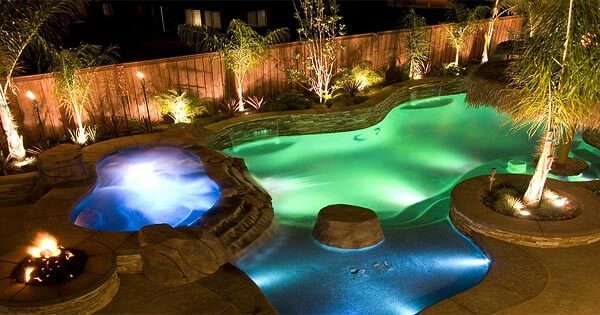FREE Standard Shipping On All Orders $100 or More!*
Landscape Lighting Tips from the Pros

Landscape lighting is one of those details that can really make a backyard... shine!
Use landscape lighting to accentuate various features; plants/trees, outdoor art, water features or walkways.
 USE MORE THAN ONE LIGHT
USE MORE THAN ONE LIGHT
"If you wish to highlight a single item in your garden like a statue, gazing ball or fountain, you should consider using a few landscape lighting fixtures with lower intensity bulbs. Place these at various angles and distances. A single bright light shining directly on the object will create harsh shadows." Sandra Peterson, HGTV.com
 MAKE A SKETCH OF THE YARD
MAKE A SKETCH OF THE YARD
"After you have defined your reasons for wanting to add landscape lighting, sketch your yard. Include in the sketch existing lights, buildings, benches, trees and shrubs, as well as the vegetation and decorations in the garden. Each of these items will reflect light or absorb it. Estimate the height of each of the objects, especially the foliage." Sandra Peterson, HGTV.com
 HIDE THE SPOT LIGHTS
HIDE THE SPOT LIGHTS
"In order to hide light fixtures so they're not noticeable day or night, pile rocks around the fixture or use light shields. At night you'll see the light peeking out from the rocks, giving its magical look to the stone, and nobody gets glare in their eye, no matter how they look at the fountain." - Michael Sestak, Designer
 AVOID LIGHT POLLUTION
AVOID LIGHT POLLUTION
"Aim lights carefully. Position lights at night and check their position frequently. Shield bulbs. Use fixtures that have reflectors and shielding to concentrate light where you want it. Minimize wattage. Higher wattage will create harsher light without improving aesthetics or increasing safety. Control the light. Separately zoned lights with timers, controls, dimmers, or motion sensors will turn on lights only when needed." - Kelly Roberson, Better Homes & Gardens
 ADD LIGHT, NOT ENERGY
ADD LIGHT, NOT ENERGY
"One of the simplest ways to save on electricity costs is to use a photocell, when it becomes dark or daylight, the photocell automatically turns the lights on and off. Another common type of control is a timer that turns the lights on and off at specific times." Joe Rey-Barreau, American Lighting Assn
 A LITTLE LIGHT GOES A LONG WAY
A LITTLE LIGHT GOES A LONG WAY
"When laying out your project, remember a little light goes a long way outdoors. I see this happen a lot with path lighting, folks will place fixtures six to eight feet apart when lighting a sidewalk, and they end up using 10 fixtures for a 50- to 60-foot path. That path can easily be illuminated with three to four fixtures." - Lew Waltz, Hadco Lighting
 HOW DOES IT LOOK FROM THE HOUSE?
HOW DOES IT LOOK FROM THE HOUSE?
"What's it look like from the inside? Consider how patio spaces, gardens and pathways look like from inside your home. Light gardens or shrubbery that can be seen from living or dining rooms give a room-expanding view to the outside at night." - Mark Raissen, Lamps Plus
 DOWNLIGHTING OR UPLIGHTING?
DOWNLIGHTING OR UPLIGHTING?
"Mount shielded bullet fixtures up in taller trees to shine down, like moonlight, on a shorter tree or nearby shrubs. The downlight passes through branches and leaves, casting an interesting pattern of shadows. For a backlit effect, put the light source between the object you want to highlight and a wall or fence." - Lloyd Reeder, Greenlee Lighting
 MAKE THE POOL A REFLECTING POND
MAKE THE POOL A REFLECTING POND
"Low lights on the far end of the pool, pointing away from the pool, to highlight a focal point, or to simply wash across the back fence, can make a soothing glow across the pool, when viewed from inside the house or on the back patio." - Janet Strait, Lightscapers, inc.
If your backyard is dark at night, make your pool pop with a few well placed lights to create visual interest or highlight focal points, and also improve pool safety by lighting up dark areas.